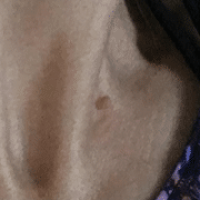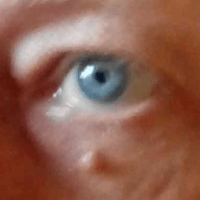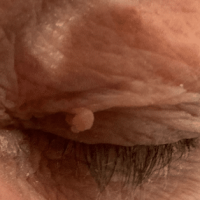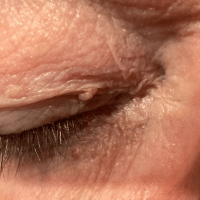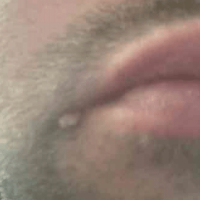What Are Skin Tags?
Skin tags are small, soft, flesh-coloured or brown growths that hang off the skin. They can range in size from just a few millimetres to several centimetres and may appear singly or in clusters.
These growths are made of loose collagen fibres, blood vessels, and skin tissue. Some skin tags are attached to the skin by a thin stalk (called a peduncle), while others are more broad-based.
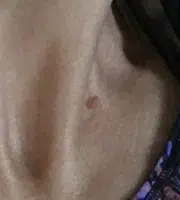
🧬 Skin Tags Explained
Medical name: Fibroepithelial Polyp
Appearance: Flesh-toned or darker, soft, and movable
Locations: Commonly found on the neck, underarms, eyelids, groin, and under the breasts
Symptoms: Usually painless and non-cancerous
Although skin tags are almost always harmless, they can:
Catch on clothing or jewellery, causing irritation or bleeding
Become a cosmetic concern, especially in visible areas
Occasionally be confused with moles or warts, which is why professional diagnosis is advised
Why Would I Want to Remove a Skin Tag?
Many patients choose to have skin tags removed for both cosmetic and practical reasons. While skin tags are harmless, they can still cause issues that affect your daily life or confidence.
🔹 Cosmetic Concerns
Skin tags often appear on the face, neck, or eyelids — areas where they are easily seen. For many people, this can cause:
Embarrassment
Reduced confidence
Concerns about how they look in photos or public
🔹 Physical Irritation
Skin tags can also:
Catch on clothing or jewellery
Rub against skin folds (especially underarms or groin)
Occasionally cause pain or bleeding when irritated
Skin Tag Removal Under Local Anaesthetic – Always Pain-Free
At TVSS, we carry out all skin tag removal procedures under local anaesthetic, ensuring a completely pain-free experience. Whether you have one skin tag or many, we prioritise your comfort, safety, and cosmetic outcome.
How We Remove Skin Tags
Most skin tags are narrow-based, which makes removal simple and minimally invasive. Depending on the location and size, we may use one of the following techniques:
🔹 Shave Excision
Our most commonly used method
Provides excellent cosmetic results
Quick healing and often leaves no noticeable mark
🔹 Surgical Excision with Sutures
Used for larger or broad-based tags
Offers the most secure closure and best cosmetic outcome
We typically use non-dissolvable stitches, which are removed at a short follow-up visit for optimal healing
🔹 Electrodessication or Radiofrequency Cautery
Ideal for small or surface-level skin tags
Uses controlled heat to remove and seal
Fast and effective with minimal aftercare
The most suitable technique will be discussed with you during your consultation.
More health and technical information about skin tags
Self Diagnosis
How Can I Self-Diagnose Skin Tags?
If the growths on your skin look like the examples shown above, there’s a strong chance they are skin tags — especially if they are soft, flesh-coloured, and appear to be hanging from the skin.
Skin tags typically:
Are painless
Have a thin stalk or appear slightly raised
Occur in areas where skin rubs on skin or clothing (e.g. neck, eyelids, underarms, groin)
However, not all small growths are skin tags. Conditions like moles, warts, or other benign lesions can sometimes look similar.
⚠️ When in doubt, it’s always safer to get a professional opinion.
You can speak to your GP or book an appointment with us for expert advice and, if needed, fast and safe skin tag removal.
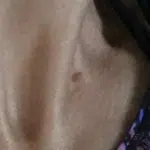
Who gets them?
Who Gets Skin Tags?
Skin tags are very common and can affect both men and women of any age. While they can develop in anyone, certain groups are more prone to developing them.
🔹 Common Risk Factors for Skin Tags
Skin folds and friction: Skin tags are more likely to appear in areas where the skin rubs against itself or clothing, such as the neck, underarms, groin, and under the breasts
Being overweight or obese: Increased skin friction makes skin tags more likely
Type 2 diabetes: Skin tags are more frequently seen in people with insulin resistance
Pregnancy: Hormonal changes can trigger new skin tags
Family history: Skin tags may be hereditary
Sometimes, skin tags can develop for no obvious reason, even in healthy individuals with no risk factors.
Prevention
How Can I Prevent Skin Tags from Growing Bigger or Coming Back After Removal?
The truth is, we don’t fully understand why skin tags form, and there’s no guaranteed way to prevent them from growing or reappearing after removal. However, we do know that certain risk factors can make them more likely to return.
🔹 Solitary Skin Tags
If you’ve only had one or two skin tags, they often don’t return after removal. These cases may be sporadic and not linked to an underlying cause.
🔹 Multiple Skin Tags (especially around the neck)
In patients with clusters of skin tags, especially in areas like the neck, there may be contributing factors such as:
Obesity
Friction from clothing or jewellery
Insulin resistance or type 2 diabetes
In such cases, skin tags are more likely to reappear unless these contributing factors are addressed. For example, weight loss or improved blood sugar control may help reduce the recurrence.
While we can’t guarantee they won’t come back, our clinic ensures complete removal of each skin tag during treatment to minimise the chance of regrowth at the same site.
Getting bigger?
Do Skin Tags Get Bigger Over Time?
Yes — skin tags often grow slowly but steadily over time. While they may start as tiny, soft bumps, they can gradually increase in size, especially if located in areas of friction like the neck, underarms, groin, or under the breasts.
At our clinic, we’ve removed very large skin tags, including some measuring up to 10cm in length. Skin tags can also occur in private or sensitive areas, where they may cause particular discomfort or embarrassment.
📌 Why Consider Early Removal?
Smaller skin tags are easier to remove and usually heal faster
Early removal often offers better cosmetic results
Prevents them from catching, bleeding, or causing irritation as they grow
If you’re concerned about a skin tag becoming larger or changing over time, we’re happy to assess and recommend the most suitable removal option.
Other Health Considerations
Anything Else I Should Be Aware Of?
If you’re unsure whether a bump is truly a skin tag, it’s best to get a professional diagnosis. While skin tags are usually harmless, moles, warts, and other skin conditions can sometimes look similar — and may require different treatment.
Treatment
Who Should Consider Skin Tag Removal Surgery?
You may want to consider professional skin tag removal if:
The skin tag is unsightly and affecting your confidence or self-esteem
It is located in a cosmetically sensitive area (e.g. face, neck, eyelids)
It snags on clothing or jewellery, causing irritation or bleeding
You have multiple skin tags in areas of friction (such as the neck or underarms)
You want a definitive diagnosis and lab analysis for peace of mind
Why Choose Professional Surgical Removal?
At our clinic, we provide safe, doctor-led removal of skin tags using minor surgical techniques tailored to your needs.
Some people have many skin tags, often around the neck or body folds
Others may have just one very large skin tag, which may require careful excision
We offer the following options for pain relief:
Local anaesthetic injection (e.g. Lidocaine) for complete numbness
Topical anaesthetic cream (e.g. EMLA Cream) as a needle-free option
We typically remove skin tags using electrosurgical equipment (radiofrequency or electrocautery), which:
Allows us to shave the tag cleanly
Seals the skin at the same time to minimise bleeding
Results in minimal or no scarring
For your reassurance, we can also send removed skin tags for histological analysis in a medical laboratory, ensuring complete peace of mind.
Cost £225 +
Cost of Skin Tag Removal – From £225*
At our clinic, skin tag removal is safe, straightforward, and affordable. We price based on size, location, and the number of tags treated during your visit.
💷 Typical Prices
Small skin tag (e.g. neck tag): £225*
Medium skin tag (e.g. on the body): Approximately £225*
Facial skin tags: Typically £225* – £275*, especially on the eyelids or delicate areas
Very large skin tags (e.g. in private/sensitive areas or requiring stitches): Priced individually depending on complexity. May add up to £150 if full cut excision
➕ Additional Skin Tags
Most additional skin tags: £25 to £75 each
Special pricing may be available for patients with numerous small skin tags, especially around the neck or underarms
Note: The above prices include a £60 discount if your treatment is booked within 1 month of your initial consultation.
Consultation and Additional Costs
A consultation fee applies unless you are a returning patient
Laboratory testing, if required (rare), is charged separately
For full pricing details, visit our Skin Surgery Fees page
⏱️ Timed Appointments for Multiple Skin Tags
If you have a large number of skin tags, we offer timed appointments at a reduced rate — ideal for those seeking bulk removal in a single session. Ask us during your consultation for more details.
My Skin Tag Has Been Classed as a Cosmetic Problem
If your GP has told you the skin tag is cosmetic, you can contact us directly — no referral is needed.
Please note: Private health insurance in the UK does not usually cover cosmetic skin tag removal. This advice may not apply to non-UK residents.
Self Removal
Can I Remove Skin Tags Myself?
While some people do attempt to remove skin tags at home, it is generally not recommended. Online, you may see suggestions involving tying them off, burning, or cutting them with tools — but these methods carry significant risks if not done correctly.
⚠️ Potential Risks of DIY Skin Tag Removal
Bleeding
Infection
Scarring
Mistaking a skin tag for something else (e.g. mole, wart, or other lesion)
If you are still considering removing skin tags yourself, you must have a very good understanding of disinfection, sterility, and bleeding control. Most people understandably do not have the tools, experience, or environment to perform this safely.
At your consultation, we’re happy to explain your options — including safe clinical removal and any information you need to make an informed decision.
What Next?
Make an Appointment
To arrange your skin tag removal or consultation, you can:
- Contact us directly via phone or email
- Book a clinic appointment online at your convenience
- Request a telephone consultation if you’d like to speak to a doctor before deciding
If you request a telephone consultation, please make sure to read our
“How TVSS Works” page in full to understand the process.
Concerned about pain? We offer gentle and pain-free skin tag removal using local or topical anaesthetic — most patients experience little or no discomfort during treatment.
More Information: For definitions of common terms in skin and minor surgery,
click here to view our glossary.
More Information
More Information
For further reading, we recommend this excellent overview of skin tags on DermNet — one of the most trusted and authoritative dermatology resources in the world.
Accessibility Information:
Accessibility & Clinic Location
Our clinic in Bourne End, Buckinghamshire offers easy access for patients across the South East of England seeking expert minor skin surgery and milia removal. We’re strategically positioned near major roadways and connected to London and surrounding counties via excellent public transport links.
📍 Nearby Local Areas (within 20–30 minutes)
Bourne End, Marlow, Henley-on-Thames, Twyford
Maidenhead, Windsor, Ascot, Slough
Gerrards Cross, Beaconsfield, Chalfont St Peter
Uxbridge, West Drayton, Egham
🚆 Easy Access via the Elizabeth Line (West & East London)
We’re directly connected to Central and East London via the Elizabeth Line, making travel fast and simple from:
West London: Paddington, Ealing, Acton, Southall, Hayes
Central London: Bond Street, Tottenham Court Road, Farringdon, Liverpool Street
East London: Whitechapel, Stratford, Ilford, Romford, Chadwell Heath, Shenfield
This makes us an ideal choice for patients looking for milia removal in London without long waiting lists or inflated city-centre pricing.
🛣️ Convenient from the M4, M40 & A404
Easily accessible from key regional towns including:
Bracknell, Reading, Wokingham, Staines, Virginia Water
Richmond, Twickenham, Northolt, Harrow, Wembley
Woking, Farnborough, Guildford, Basingstoke
🌍 Wider Regions (within 45 minutes to 2 hours)
Many patients also travel to us from:
Oxfordshire: Oxford, Banbury, Thame, Didcot
Buckinghamshire & Milton Keynes
South East counties: Surrey, Hampshire, Sussex, Kent, Essex
South Coast: Southampton, Portsmouth, Brighton, Eastbourne
South West: Swindon, Bath, Bristol
Even parts of South Wales, via the M4
🧭 Why Patients Travel to Us
Patients choose us from across the region for our:
Fast access with minimal travel time
Convenient online booking and flexible consultation options
Reputation for safe, efficient, and pain-free milia removal

